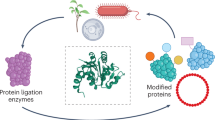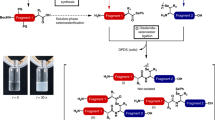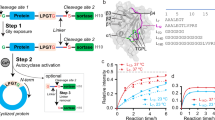Abstract
The preparation of synthetic molecules showing the remarkable efficiencies characteristic of natural biopolymer catalysts remains a formidable challenge for chemical biology. Although significant advances have been made in the understanding of protein structure and function, the de novo construction of such systems remains elusive1,2,3,4,5. Re-engineered natural enzymes and catalytic antibodies, possessing tailored binding pockets with appropriately positioned functional groups, have been successful in catalysing a number of chemical transformations, sometimes with impressive efficiencies6,7,8,9,10,11. But efforts to produce wholly synthetic catalytic peptides have typically resulted in compounds with questionable structural stability, let alone reactivity1. Here we describe a 33-residue synthetic peptide, based on the coiled-coil structural motif12,13,14, which efficiently catalyses the condensation of two shorter peptide fragments with high sequence- and diastereoselectivity. Depending on the substrates used, we observe rate enhancements of tenfold to 4,100-fold over the background, with catalytic efficiencies in excess of 104. These results augur well for the rational design of functional peptides.
This is a preview of subscription content, access via your institution
Access options
Subscribe to this journal
Receive 51 print issues and online access
$199.00 per year
only $3.90 per issue
Buy this article
- Purchase on Springer Link
- Instant access to full article PDF
Prices may be subject to local taxes which are calculated during checkout





Similar content being viewed by others
References
Corey, M. J. & Corey, E. On the failure of de novo-designed peptides as biocatalysts. Proc. Natl Acad. Sci. USA 93, 11428–11434 (1996).
Johnsson, K., Allemann, R. K., Widmer, H. & Benner, S. A. Synthesis, structure and activity of artificial, rationally designed catalytic polypeptides. Nature 365, 530–532 (1993).
Bryson, J. W. Protein design—a hierarchic approach. Science 270, 935–941 (1995).
Lee, D. H., Granja, J. R., Martinez, J. A., Severin, K. S. & Ghadiri, M. R. Aself-replicating peptide. Nature 382, 525–528 (1996).
Severin, K. S., Lee, D. H., Martinez, J. A. & Ghadiri, M. R. Peptide self-replication via template-directed ligation. Chem. Eur. J. 3, 1017–1024 (1997).
Schultz, P. G. & Lerner, R. A. From molecular diversity to catalysis—lessons from the immune system. Science 269, 1835–1842 (1995).
Macbeath, G. & Hilvert, D. Hydrolytic antibodies—variations on a theme. Chem. Biol. 3, 433–445 (1996).
Kirby, A. J. The potential of catalytic antibodies. Acta Chem. Scand. 50, 203–210 (1996).
Kaiser, E. T. Catalytic activity of enzymes altered at their active sites. Angew. Chem. Int. Edn Engl. 27, 913–922 (1988).
Douglas, K. T. Alteration of enzyme specificity and catalysis. Curr. Opin. Biotechnol. 3, 370–377 (1992).
Wong, C.-H. & Whitesides, G. M. Enzymes in Synthetic Organic Chemistry (Pergamon, New York, (1994)).
Hu, J. C., O'Shea, E. K., Kim, P. S. & Sauer, R. T. X-ray structure of the GCN4 leucine zipper, a 2-stranded, parallel coiled coil. Science 250, 1400–1403 (1990).
Harbury, P. B., Zhang, T., Kim, P. S. & Alver, T. Aswitch between two-, three-, and four-stranded coiled coils in GCN4 leucine zipper mutants. Science 262, 1401–1407 (1993).
Lovejoy, B. et al. Crystal structure of a synthetic triple-stranded alpha-helical bundle. Science 259, 1288–1293 (1993).
Lumb, K. J. & Kim, P. S. Measurement of interhelical electrostatic interactions in the GCN4 leucine zipper. Science 268, 436–439 (1995).
Monera, O. D., Kay, C. M. & Hodges, R. S. Electrostatic interactions control the parallel and antiparallel orientation of α-helical chains in two-stranded α-helical coiled-coils. Biochemistry 33, 3862–3871 (1994).
Zhou, N. E., Kay, C. M. & Hodges, R. S. The role of interhelical ionic interactions in controlling protein folding and stability- de novo designed synthetic two-stranded α-helical coiled-coils. J. Mol. Biol. 237, 500–512 (1994).
O'Shea, E. K., Lumb, K. J. & Kim, P. S. Peptide ‘velcro’: design of a heterodimeric coiled coil. Curr. Biol. 3, 658–667 (1993).
Graddis, T. J., Myszka, D. G. & Chaiken, I. M. Controlled formation of model homo- and heterodimer coiled coil polypeptides. Biochemistry 32, 12664–12671 (1993).
Dawson, P. E., Muir, T. W., Clark-Lewis, I. & Kent, S. B. H. Synthesis of proteins by native chemical ligation. Science 266, 776–779 (1994).
Jencks, W. P. Catalysis in Chemistry and Enzymology 537–542 (Dover, New York, (1987)).
Martin, R. B. & Hedrick, R. I. Intramolecular S–O and S–N acetyl transfer reactions. J. Am. Chem. Soc. 84, 106–110 (1962).
Bruice, T. R. & Fedor, L. R. Kinetic demonstration of a metastable intermediate in a nucleophile displacement at a thiol ester bond. J. Am. Chem. Soc. 86, 738–739 (1964).
Muir, T. W., Dawson, P. E., Fitzgerald, M. C. & Kent, S. B. H. Probing the chemical basis of binding activity in an SH3 domain by protein signature analysis. Chem. Biol. 3, 817–825 (1996).
Hirschmann, R. et al. Peptide synthesis catalyzed by an antibody containing a binding site for variable amino acids. Science 256, 234–237 (1994).
Jacobsen, J. R. & Schultz, P. G. Antibody catalysis of peptide bond formation. Proc. Natl Acad. Sci. USA 91, 5888–5892 (1994).
Smithrud, D. B. et al. Investigations of an antibody ligase. J. Am. Chem. Soc. 117, 278–282 (1997).
Abrahamsen, L. et al. Engineering subtilisin and its substrates for efficient ligation of peptide bonds in aqueous solution. Biochemistry 30, 4151–4159 (1991).
Kirby, A. J. Enzyme mechanisms, models, and mimics. Angew. Chem. Int. Edn Engl. 35, 707–724 (1996).
Tam, J. P., Lu, Y.-A., Liu, C.-F. & Shao, J. Peptide synthesis using unprotected peptides through orthogonal coupling methods. Proc. Natl Acad. Sci. USA 92, 12485–12489 (1995).
Kemp, D. S. & Carey, R. I. Synthesis of a 39-peptide and a 25-peptide by thiol capture ligations—observation of a 40-fold rate acceleration of the intramolecular O,N-acyl-transfer reaction between peptide fragments bearing only cysteine protective groups. J. Org. Chem. 58, 2216–2222 (1993).
Acknowledgements
We thank D. Hilvert and K. Kumar for helpful discussions. We also thank the National Institutes of Health (NIGMS) for a postdoctoral fellowship (A.J.K.), the Medical Research Council of Canada for a predoctoral fellowship (D.H.L.), and the Deutsche Forschungsgemeinschaft for a postdoctoral fellowship (K.S.).
Author information
Authors and Affiliations
Corresponding author
Rights and permissions
About this article
Cite this article
Severin, K., Lee, D., Kennan, A. et al. A synthetic peptide ligase. Nature 389, 706–709 (1997). https://doi.org/10.1038/39556
Received:
Accepted:
Issue Date:
DOI: https://doi.org/10.1038/39556
This article is cited by
-
Biomimetic and bioorthogonal nanozymes for biomedical applications
Nano Convergence (2023)
-
The Phylogenomic Roots of Modern Biochemistry: Origins of Proteins, Cofactors and Protein Biosynthesis
Journal of Molecular Evolution (2012)
-
Selective amplification by auto- and cross-catalysis in a replicating peptide system
Nature (1998)
-
Emergence of symbiosis in peptide self-replication through a hypercyclic network
Nature (1997)
Comments
By submitting a comment you agree to abide by our Terms and Community Guidelines. If you find something abusive or that does not comply with our terms or guidelines please flag it as inappropriate.



